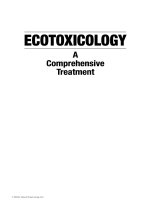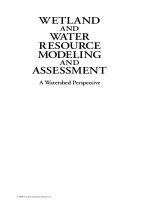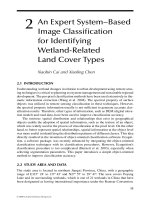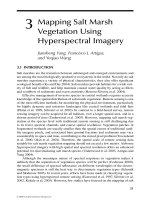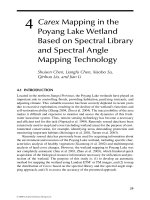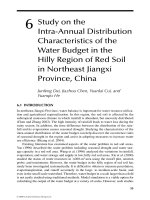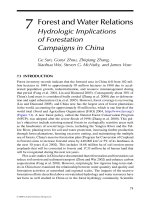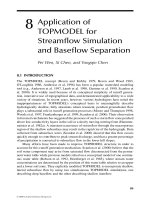WETLAND AND WATER RESOURCE MODELING AND ASSESSMENT: A Watershed Perspective - Chapter 1 ppt
Bạn đang xem bản rút gọn của tài liệu. Xem và tải ngay bản đầy đủ của tài liệu tại đây (694 KB, 38 trang )
WETLAND
AND
WATER
RESOURCE
MODELING
AND
ASSESSMENT
A Watershed Perspective
© 2008 by Taylor & Francis Group, LLC
Boreal Shield Watersheds: Lake Trout Ecosystems
in a Changing Environment
Edited by J.M. Gunn, R.J. Steedman, and R.A. Ryder
The Economics of Groundwater Remediation and Protection
Paul E. Hardisty and Ece Özdemirog˘lu
Forests at the Wildland–Urban Interface:
Conservation and Management
Edited by Susan W. Vince, Mary L. Duryea, Edward A. Macie,
and L. Annie Hermansen
Handbook of Water Sensitive Planning and Design
Edited by Robert L. France
Porous Pavements
Bruce K. Ferguson
Restoration of Boreal and Temperate Forests
Edited by John A. Stanturf and Palle Madsen
Wetland and Water Resource Modeling and Assessment:
A Watershed Perspective
Edited by Wei Ji
Integrative Studies in
Water Management and Land Development
Series Editor
Robert L. France
Published Titles
© 2008 by Taylor & Francis Group, LLC
CRC Press is an imprint of the
Taylor & Francis Group, an informa business
Boca Raton London New York
WETLAND
AND
WATER
RESOURCE
MODELING
AND
ASSESSMENT
A Watershed Perspective
Edited by Wei Ji
© 2008 by Taylor & Francis Group, LLC
CRC Press
Taylor & Francis Group
6000 Broken Sound Parkway NW, Suite 300
Boca Raton, FL 33487-2742
© 2008 by Taylor & Francis Group, LLC
CRC Press is an imprint of Taylor & Francis Group, an Informa business
No claim to original U.S. Government works
Printed in the United States of America on acid-free paper
10 9 8 7 6 5 4 3 2 1
International Standard Book Number-13: 978-1-4200-6414-8 (Hardcover)
This book contains information obtained from authentic and highly regarded sources. Reprinted
material is quoted with permission, and sources are indicated. A wide variety of references are
listed. Reasonable efforts have been made to publish reliable data and information, but the author
and the publisher cannot assume responsibility for the validity of all materials or for the conse-
quences of their use.
No part of this book may be reprinted, reproduced, transmitted, or utilized in any form by any
electronic, mechanical, or other means, now known or hereafter invented, including photocopying,
microfilming, and recording, or in any information storage or retrieval system, without written
permission from the publishers.
For permission to photocopy or use material electronically from this work, please access www.
copyright.com ( or contact the Copyright Clearance Center, Inc. (CCC)
222 Rosewood Drive, Danvers, MA 01923, 978-750-8400. CCC is a not-for-profit organization that
provides licenses and registration for a variety of users. For organizations that have been granted a
photocopy license by the CCC, a separate system of payment has been arranged.
Trademark Notice: Product or corporate names may be trademarks or registered trademarks, and
are used only for identification and explanation without intent to infringe.
Library of Congress Cataloging-in-Publication Data
Wetland and water resource modeling and assessment : a watershed perspective
/ editor, Wei Ji.
p. cm. (Integrative studies in water management and land
development)
ISBN 978-1-4200-6414-8 (alk. paper)
1. Wetlands Remote sensing. 2. Wetland ecology. 3. Ecological mapping.
4. Water resources development. 5. Watershed management. 6. Geographic
information systems. I. Ji, Wei, 1955- II. Title. III. Series.
GB622.W48 2007
553.7 dc22 2007024968
Visit the Taylor & Francis Web site at
and the CRC Press Web site at
© 2008 by Taylor & Francis Group, LLC
v
Contents
Foreword: A Wider View of Wetlands xv
Preface: Toward a Watershed Perspective xvii
Editor xxi
Editorial Advisory Board xxiii
Contributors xxv
PART I Geospatial Technologies for Wetland Mapping
Chapter 1 Application and Assessment of a GIScience Model for
Jurisdictional Wetlands Identication in Northwestern Ohio 3
Nathan Torbick, Patrick Lawrence, and Kevin Czajkowski
1.1 Introduction 3
1.2 Study Area 4
1.3 Methods 5
1.3.1 Geospatial Data 5
1.4 Wetlands Fieldwork and Regulations 6
1.4.1 Classication 7
1.4.2 Assessment 8
1.5 Results 8
1.6 Discussion 9
1.7 Conclusion 10
Acknowledgments 10
References 10
Chapter 2 An Expert System–Based Image Classication for Identifying
Wetland-Related Land Cover Types 13
Xiaobin Cai and Xiaoling Chen
2.1 Introduction 13
2.2 Study Area and Data 13
2.3 Methodology and Results 14
2.3.1 Water Body Identication and Supervised Classication 15
2.3.2 Expert Knowledge 15
2.3.3 Object Neighborhood Search and DEM Analysis 16
2.3.4 Construction of the Expert System 17
2.4 Conclusion 17
Acknowledgments 18
References 18
© 2008 by Taylor & Francis Group, LLC
vi Wetland and Water Resource Modeling and Assessment
Chapter 3 Mapping Salt Marsh Vegetation Using Hyperspectral Imagery 21
Jiansheng Yang, Francisco J. Artigas, and Yeqiao Wang
3.1 Introduction 21
3.2 Study Area and Data 22
3.3 Methods 23
3.4 Results and Discussion 24
3.5 Conclusion 27
References 27
Chapter 4 Carex Mapping in the Poyang Lake Wetland Based on Spectral
Library and Spectral Angle Mapping Technology 29
Shuisen Chen, Liangfu Chen, Xiaobo Su, Qinhuo Liu, and Jian Li
4.1 Introduction 29
4.2 Data and Methods 30
4.2.1 Data 30
4.2.2 Flooding Area Extraction 30
4.2.3 Spectral Angle Mapping (SAM) 32
4.3 Results and Discussion 33
4.4 Conclusion 36
Acknowledgments 37
References 39
PART II Wetland Hydrology and Water Budget
Chapter 5 Change in the Southern U.S. Water Demand and Supply over
the Next Forty Years 43
Steven G. McNulty, Ge Sun, Erika C. Cohen, and
Jennifer A. Moore Myers
5.1 Introduction 43
5.2 Methods 44
5.2.1 Calculations for Estimating Water Supply 44
5.2.2 Groundwater Supply Data 44
5.2.3 Historic and Projected Climate Data 45
5.2.4 Historic Land Cover and Land Use Data 46
5.2.5 Historic and Projected Population Data 47
5.2.6 Calculations for Estimating Water Demand 47
5.2.7 Calculations for Estimating the Water Supply Stress Index
(WASSI) 48
5.2.8 Water Supply Stress Scenarios 49
5.2.8.1 Scenario 1: Small Population Increase—Wet Year
(2020) 49
© 2008 by Taylor & Francis Group, LLC
Contents vii
5.2.8.2 Scenario 2: Small Population Increase—Dry Year
(2024) 49
5.2.8.3 Scenario 3: Large Population Increase—Wet Year
(2045) 49
5.2.8.4 Scenario 4: Large Population Increase—Dry Year
(2043) 49
5.2.8.5 Scenario 5: Large Population Increase—Wet Year
(2045), No Groundwater Supply (GS) 50
5.2.8.6 Scenario 6: Large Population Increase—Dry Year
(2043), No Groundwater Supply (GS) 50
5.3 Results and Discussion 50
5.3.1 Climate Controls on the WASSI 50
5.3.2 Population and Other Water Use Sector Controls on the WASSI 51
5.3.3 Ground Water Supply Controls on the WASSI 53
5.4 Summary 54
Acknowledgments 56
References 56
Chapter 6 Study on the Intra-Annual Distribution Characteristics of the
Water Budget in the Hilly Region of Red Soil in Northeast
Jiangxi Province, China 59
Junfeng Dai, Jiazhou Chen, Yuanlai Cui, and Yuanqiu He
6.1 Introduction 59
6.2 Brief Description of Model 60
6.3 Site Selection and Model Calibration 60
6.3.1 Application Site 60
6.3.2 Data Preparation 61
6.3.3 Model Calibration and Validation 62
6.4 Results and Discussion 63
6.4.1 Precipitation 63
6.4.2 Surface Runoff 64
6.4.3 Evapotranspiration 64
6.4.4 Percolation from the Bottom of the Root Zone 66
6.4.5 Water Surplus-Decit Status 67
6.5 Conclusions 67
Acknowledgments 68
References 68
Chapter 7 Forest and Water Relations: Hydrologic Implications
of Forestation Campaigns in China 71
Ge Sun, Guoyi Zhou, Zhiqiang Zhang, Xiaohua Wei,
Steven G. McNulty, and James Vose
7.1 Introduction 71
© 2008 by Taylor & Francis Group, LLC
viii Wetland and Water Resource Modeling and Assessment
7.2 Forests and Watershed Hydrology: Experimental Evidence around the
World 72
7.2.1 North America 73
7.2.2 Europe 75
7.2.3 South Africa and the Tropics 76
7.2.4 Australia 77
7.3 Debate on Forest–Water Relations in China 77
7.4 Implications of Forest–Water Relations to Forestation Campaigns in
China 80
7.5 Forest Hydrology Research Needs in China 83
Acknowledgments 84
References 85
Chapter 8 Application of TOPMODEL for Streamow Simulation and
Baseow Separation 89
Pei Wen, Xi Chen, and Yongqin Chen
8.1 Introduction 89
8.2 Modied TOPMODEL 90
8.2.1 Subsurface Flow 91
8.2.2 Surface Flow 92
8.2.3 Channel Routing 93
8.3 Application 93
8.3.1 Study Site 93
8.3.2 Model Calibration and Validation 94
8.4 Conclusions 95
Acknowledgments 96
References 98
Chapter 9 Spatially Distributed Watershed Model of Water and
Materials Runoff 99
Thomas E. Croley II and Chansheng He
9.1 Introduction 99
9.2 Agricultural Runoff Models 100
9.3 Distributed Large Basin Runoff Model 101
9.3.1 Application 104
9.3.2 Testing 106
9.4 Materials Runoff Model 107
9.4.1 Initial and Boundary Conditions 108
9.5 Example Simulation 109
9.6 Summary 109
Acknowledgments 111
References 111
© 2008 by Taylor & Francis Group, LLC
Contents ix
PART III Water Quality and
Biogeochemical Processes
Chapter 10 Estimating Nonpoint Source Pollution Loadings in the
Great Lakes Watersheds 115
Chansheng He and Thomas E. Croley II
10.1 Introduction 115
10.2 Study Area 116
10.3 Estimating Soil Erosion Potential 116
10.3.1 Water Erosion Potential 117
10.3.2 Wind Erosion Potential 118
10.4 Estimating Animal Manure Loading Potential 121
10.5 Agricultural Chemical Loading Potential 123
10.6 Critical Nonpoint Source Pollution Areas 124
10.7 Summary 124
Acknowledgments 125
References 125
Chapter 11 Simulating Historical Variations of Nitrogenous and
Phosphorous Nutrients in Honghu Lake Basin, China 129
Feng Gui, Ge Yu, and Geying Lai
11.1 Introduction 129
11.2 Study Area 129
11.3 Introduction of the SWAT Model 130
11.4 Boundary Conditions and Simulation Design 131
11.4.1 Boundary Conditions and Model Data Preparation 131
11.4.2 Simulation Procedure and Design 132
11.5 Results and Discussion 133
11.5.1 Simulation Output Analysis 133
11.5.1.1 Variability and Characteristics of Input Flow Flux 133
11.5.1.2 Nutrient Changes in a Year 134
11.5.1.3 Variations of Nutrient Concentration over Time 135
11.5.1.4 Annual TP and TN Production 135
11.5.2 Validations of Simulation Outputs 135
11.6 Conclusions 139
Acknowledgments 139
References 139
© 2008 by Taylor & Francis Group, LLC
x Wetland and Water Resource Modeling and Assessment
Chapter 12 Predictive Modeling of Lake Nitrogen, Phosphorus, and
Sediment Concentrations Based on Land Use/Land Cover Type
and Pattern 141
Pariwate Varnakovida, Narumon Wiangwang,
Joseph P. Messina, and Jiaguo Qi
12.1 Introduction 141
12.2 Methods 143
12.2.1 Land Use/Land Cover (LULC) Data 143
12.2.2 Digital Elevation Model (DEM) 143
12.2.3 Lake Sampling Method 143
12.2.4 Lakeshed Generation 144
12.2.5 Landscape Pattern Metrics 144
12.2.6 Relationships among Landscape Metrics and Water Quality
Parameters 145
12.2.7 Simulation Model 145
12.2.8 Model Verication and Validation 145
12.2.9 Sensitivity Analysis 145
12.3 Results 146
12.4 Conclusion and Discussion 147
References 149
PART IV Wetland Biology and Ecology
Chapter 13 Soil Erosion Assessment Using Universal Soil Loss Equation
(USLE) and Spatial Technologies—A Case Study at Xiushui
Watershed, China 153
Hui Li, Xiaoling Chen, Liqiao Tian, and Zhongyi Wu
13.1 Introduction 153
13.2 Study Area 154
13.3 Methods 155
13.3.1 Governing Equation 155
13.3.2 Determining the USLE Factor Values 155
13.3.2.1 Rainfall Erosivity (R) Factor 155
13.3.2.2 Soil Erodibility (K) Factor 156
13.3.2.3 Topographic Factor (LS) 156
13.3.2.4 Crop and Management Factor (C) 157
13.3.2.5 Erosion Control Practice Factor (P) 157
13.4 Results and Discussion 158
13.4.1 Factors in USLE 158
13.4.2 Erosion Intensity 161
13.5 Conclusions 162
Acknowledgments 163
References 163
© 2008 by Taylor & Francis Group, LLC
Contents xi
Chapter 14 Evaluation of Rapid Assessment Techniques for Establishing
Wetland Condition on a Watershed Scale 165
Vanessa L. Lougheed, Christian A. Parker, and R. Jan Stevenson
14.1 Introduction 165
14.2 Methods 166
14.3 Results 170
14.4 Discussion 174
Acknowledgments 176
References 176
Chapter 15 Development of Geospatial Ecological Indicators in Jiangxi
Province, China 179
Peng Guo and Xiaoling Chen
15.1 Introduction 179
15.2 Materials and Methods 180
15.2.1 Building an Evaluation Indicator System 180
15.2.2 Extraction of Water Bodies and NDVI 180
15.2.3 Statistical Methods 180
15.2.4 Principal Component Analysis 180
15.2.5 Quality Index of Ecological Environmental Background 181
15.3 Results and Discussion 181
15.4 Conclusions 185
Acknowledgments 185
References 186
Chapter 16 A Conceptual Framework for Integrating a Simulation Model of
Plant Biomass for Vallisneria spiralis L. with Remote Sensing
and a Geographical Information System 187
Guofeng Wu, Jan de Leeuw, Elly P. H. Best, Jeb Barzen,
Valentijn Venus, James Burnham, Yaolin Liu, and Weitao Ji
16.1 Introduction 187
16.2 Ecology and Production of Vallisneria 190
16.3 SAV Simulation Models 190
16.4 Conceptual Framework Integrating the SAV Simulation Model with
RS and GIS 191
16.5 Environmental Variables and Their Measurements in Poyang Lake 192
16.6 Questions to Be Addressed 196
Acknowledgments 197
References 197
© 2008 by Taylor & Francis Group, LLC
xii Wetland and Water Resource Modeling and Assessment
Chapter 17 Soundscape Characteristics of an Environment: A New
Ecological Indicator of Ecosystem Health 201
Jiaguo Qi, Stuart H. Gage, Wooyeong Joo, Brian Napoletano,
and S. Biswas
17.1 Introduction 201
17.2 Acoustic Signal Classication 202
17.3 Soundscape Analysis 203
17.3.1 Ecological Soundscapes 203
17.3.2 Development of Soundscape Indicators 203
17.4 A Sample Application 205
17.5 Discussion and Conclusions 206
Acknowledgments 210
References 210
PART V Watershed Assessment and Management
Chapter 18 Geospatial Decision Models for Assessing the Vulnerability of
Wetlands to Potential Human Impacts 215
Wei “Wayne” Ji and Jia Ma
18.1 Introduction 215
18.2 Geospatial Decision Models 216
18.2.1 Determination of Indicators and Metrics 217
18.2.2 Determination of Decision Criteria 220
18.2.3 Calculation of Wetland Vulnerability Index 221
18.3 Decision Support GIS for Model Implementation 222
18.3.1 Geospatial Data Management Function 222
18.3.2 Analytical Query Function 223
18.3.3 Vulnerability Assessment Modeling Function 225
18.3.4 Assessment Result Output Function 225
18.4 Model Application 225
18.4.1 Study Area and Geospatial Data 225
18.4.2 Results and Validation 227
18.5 Conclusions and Discussions 228
References 229
Chapter 19 Watershed Science: Essential, Complex, Multidisciplinary, and
Collaborative 231
R. Jan Stevenson, Michael J. Wiley, Stuart H. Gage,
Vanessa L. Lougheed, Catherine M. Riseng, Pearl Bonnell,
Thomas M. Burton, R. Anton Hough, David W. Hyndman,
John K. Koches, David T. Long, Bryan C. Pijanowski,
Jiaquo Qi, Alan D. Steinman, and Donald G. Uzarski
© 2008 by Taylor & Francis Group, LLC
Contents xiii
19.1 Watershed Science: Essential 231
19.2 Watershed Science: Complex 233
19.2.1 Assessment Design 233
19.2.2 Assessment Characterization 237
19.2.3 Assessment Diagnosis 238
19.2.4 Assessment Forecasting 240
19.2.5 Managing Complexity 240
19.3 Watershed Science: Multidisciplinary and Collaborative 240
Acknowledgments 242
References 242
Appendix: Muskegon Partnership Data Sharing Agreement 244
Chapter 20 Integrated Modeling of the Muskegon River: Tools for
Ecological Risk Assessment in a Great Lakes Watershed 247
Michael J. Wiley, Bryan C. Pijanowski, R. Jan Stevenson ,
Paul Seelbach, Paul Richards, Catherine M. Riseng,
David W. Hyndman, and John K. Koches
20.1 Introduction 247
20.1.1 Methodology 248
20.1.2 MREMS Component Models 250
20.1.3 The MRI-VSEC Framework 251
20.2 Preliminary Results for a Rapid Development Scenario 253
20.2.1 Discussion 256
20.2.2 Future Plans and Benchmarks 256
Acknowledgments 257
References 257
Chapter 21 Watershed Management Practices for Nonpoint Source
Pollution Control 259
Shaw L. Yu, Xiaoyue Zhen, and Richard L. Stanford
21.1 Introduction 259
21.1.2 Effects of Urbanization on the Water Environment 259
21.1.2.1 Hydrology 260
21.1.2.2 Water Quality and Ecological Impacts 261
21.2 Watershed Management Strategy and Practices 262
21.2.1 The TMDL Control Strategy 262
21.2.2 Best Management Practice (BMP) Technology 263
21.3 Practices for Eco-Friendly Urban Development and Highway
Construction 263
21.3.1 Low-Impact Development (LID) Techniques 263
21.3.2 Bioretention 264
21.3.3 Grassed Swales 265
21.3.4 Ecological Detention Systems 266
© 2008 by Taylor & Francis Group, LLC
xiv Wetland and Water Resource Modeling and Assessment
21.4 The Big Challenge Ahead 267
21.4.1 Implementation Issues in China 268
21.4.1.1 Regulatory Framework 268
21.4.1.2 Cost and Maintenance 268
21.4.1.3 Technical Issues 269
21.4.1.4 Other Issues 269
21.5 Conclusions and Recommendations 269
References 270
© 2008 by Taylor & Francis Group, LLC
xv
Foreword:
A Wider View of Wetlands
There are few landforms that have been treated with the same degree of distrust, dis-
taste, disdain, and destruction as have wetlands (e.g., R. France, ed. 2007. Wetlands
of Mass Destruction: Ancient Presage for Contemporary Ecocide in Southern Iraq).
Part of the reason for this comes about from the reality that we both literally and
guratively do not quite know where we stand in relation to wetlands; they are nei-
ther land, nor water, but exist as some uncomfortable nether region situated between
the two (R. France, ed. 2008. Healing Natures, Repairing Relationships: New Per-
spectives on Restoring Ecological Spaces and Consciousness). Our language also
reects the pejorative view that much of society has of wetlands, for who has not
felt “swamped” at one time or another by being “bogged” down through having too
much work due to being “mired” in details?
The present volume, edited by Wei “Wayne” Ji, offers a counterpoint to such
a gloomy worldview. Wetlands as described in these pages are shown to be very
much centers of hydrological and ecological importance in the landscape, a view that
would have certainly found resonance with that nineteenth-century wetland enthusi-
ast, Henry David Thoreau (R. France. 2003. Protably Soaked: Thoreau’s Engage-
ment with Water). And it is here, with its overall message of demonstrating the
cardinal need to reinsert wetlands back into their landscape, where the present book
succeeds most admirably. Wetlands are not isolated entities but rather inuence, and
are in turn inuenced by, a vast variety of environmental and anthropogenic fac-
tors (R. France. 2003. Wetland Design: Principles and Practices for Landscape
Architects and Land-Use Planners). In order to preserve the environmental integrity
of wetlands it is necessary to circumvent the strange imbalance that exists between
the scale at which wetland losses are felt by society and the scale at which wetlands
have traditionally been studied or managed. The present book, Wetland and Water
Resource Modeling and Assessment: A Watershed Perspective, anchors the goal of
holistic management in a rm scientic grounding.
The bulk of the chapters in the present volume originated from a conference.
Editor W. Ji took the wise step, however, as taken in several other volumes in this
series (R. France, ed. 2002. Handbook of Water Sensitive Planning and Design; and
R. France. 2008. Handbook of Regenerative Landscape Design), to actively solicit
contributions from others who did not present at the conference in order to better
address the book’s overall objective. The result is a well-rounded whole with the
myriad subjects being truly catholic in scope, including, for example, various spatial
mapping approaches, hydrological models, ecological appraisals, and water quality
and biogeochemistry investigations, many directed toward understanding threats on
wetlands posed by climate change and water imbalances, chemical contamination
and eutrophication, and land-use alterations and soil erosion, to name just a few. In
© 2008 by Taylor & Francis Group, LLC
xvi Wetland and Water Resource Modeling and Assessment
this respect, the present book is a worthy addition to the aspirations of the series Inte-
grative Studies in Water Management and Land Development by Taylor & Francis.
In the end, it is only by recognizing the essentialness of a watershed approach for
understanding and managing landscapes (e.g., R. France, ed. 2005. Facilitating
Watershed Management: Fostering Awareness and Stewardship; R. France. 2006.
Introduction to Watershed Development: Understanding and Managing the Impacts
of Sprawl) that wetlands can be properly assessed and modeled, as the collective
voices of the authors reiterate time and again within these pages.
Finally, the international scope of the present volume is worth noting — an addi-
tional attribute of this series whose previous books have featured case studies from
North America, Southeast Asia, and much of Europe, in addition to Australia and
Brazil. The majority of this volume’s authors originate from China, also the location
of much of the research contained herein. Perhaps this should not be surprising. The
Chinese have long recognized the multifaceted importance of wetlands. For exam-
ple, I begin chapter 1, “Foundations,” in my primer Wetland Design: Principles and
Practices for Landscape Architects and Land-Use Planners (W.W. Norton, 2003)
with the following sentence: “Early in the last millennium, a Chinese military com-
mander retired to the old picturesque town of Suzhou. There, by drawing water from
one of its famous canals, he created a marvelous garden retreat for emotional and
spiritual peace . . . [the] Chanlang ting (Pavilion of Blue Waves).” The present book
continues this foundational tradition, in this case emphasizing the importance of
viewing wetlands in a watershed perspective.
Robert L. France
Harvard University
© 2008 by Taylor & Francis Group, LLC
xvii
Preface:
Toward a Watershed Perspective
This is a book about the methods and geospatial techniques for modeling and assess-
ing wetlands and water resources at the watershed scale. As background, I would
like to start with a brief introduction with an example from Poyang Lake. Situated in
Jiangxi Province, it is the largest freshwater lake in China, with many marshes, grass-
lands, and alluvial oodplains in its watershed. The wetland area of Poyang Lake
Basin has diverse ora and fauna and provides important habitats for many migra-
tory birds. As a wetland of international importance (referred to as “Poyanghu” on
the Ramsar List of Wetlands of International Importance, 1992) with a unique land
use history, Poyang Lake has attracted great attention, domestically and internation-
ally, from research and conservation organizations. In 2004 the Chinese Ministry
of Education established a facility for lake and watershed research—the Key Lab of
Poyang Lake Ecological Environment and Resource Development, which is housed
in Jiangxi Normal University. The lab soon became very instrumental in attracting
scientists and scholars for collaborative research. Between June 27 and 30, 2005, the
lab organized and hosted a productive academic meeting at Jiangxi Normal Univer-
sity: The International Conference on Poyang Lake Complex Environment System
and Advanced Workshop on Watershed Modeling and Water Resources Manage-
ment. This event attracted scholars and professionals from China, North America,
and Europe, who presented research ndings and technical developments related to
issues in wetland and water resource science and management.
Many of the papers presented at that conference are included in this book. How-
ever, the book is not simply the conference proceedings. The editorial advisory board
selected the conference papers and also invited papers from recognized experts in
order to better present the theme of the book. All submissions were peer reviewed
and the best of them appear in this volume.
The theme of the book, wetland and water resource modeling and assessment,
is an active eld of research that constantly undergoes theoretical and technical
innovations. This book emphasizes a watershed perspective in the modeling and
assessment areas. The term watershed means a geographic area where water drains
into a body of water such as a river, lake, or wetland. Other terms are often used
to describe the same concept, such as river basin, drainage basin, and catchment
area. Since the early 1990s, watershed management or the watershed approach—
coordinated resource planning and management based on hydrologically dened
geographic areas—has been promoted as a common strategy of water resource stew-
ardship and other related environmental activities. In 2000 the U.S. Departments
of Agriculture and the Interior announced a unied policy to protect water quality
and aquatic ecosystems on federal lands. The policy serves as a framework for land
and resource management focused on watersheds. This policy has been supported
© 2008 by Taylor & Francis Group, LLC
xviii Wetland and Water Resource Modeling and Assessment
by the U.S. Departments of Commerce, Defense, and Energy; the Environmental
Protection Agency; the Tennessee Valley Authority; and the U.S. Army Corps of
Engineers. Similar trends have occurred on other continents. For example, a pilot
study on integrated water management, launched by NATO/CCMS (North Atlantic
Treaty Organization/Committee on the Challenges of Modern Society) in 2002, was
conducted through a series of workshops involving representatives from the NATO
countries. While I was traveling in the Biebrza National (wetlands) Park in Poland in
the summer of 2006, I had the good fortune to participate in part of this pilot study’s
sixth workshop held there. I was impressed by the vision and breadth of the study
for implementing water management based on the “river basins” across Europe.
Within Jiangxi Province, China, the surface water of approximately 95% of its land
drains into Poyang Lake through several major rivers. The hydrological feature of
this watershed is quite unique and important to water resources, biology, ecology,
and socioeconomic development in the region. Thus, the watershed perspective in
the research and management of the Poyang Lake ecosystem has a long tradition.
Sound watershed-based water resource planning and management should rest
on scientically justiable data and innovative technical tools. Thus, assessment and
modeling of key processes of terrestrial and aquatic ecosystems are crucial to the
success of watershed management, which is becoming, as demonstrated in the stud-
ies included in this book, an active eld of research and technical development.
With a watershed perspective, ecosystem assessment and modeling commonly pos-
sess the following major characteristics: (1) Sufciently large spatial scales in data
collection and analysis in order to encompass major watershed features. This often
leads to using remote sensing and GIS (geographic information system) for data
acquisition and integration, as well as for spatial analysis. (2) Inclusion of landscape
features in order to appropriately characterize watershed hydrological processes and
related ecosystem components. This usually requires relating land cover and land
use dynamics to water features. (3) Linking assessment or modeling results to man-
agement decisions for specic objectives. This often results in the development of
decision support tools to facilitate ecosystem assessment under various management
scenarios and criteria. These characteristics of watershed assessment and modeling
can be found in many of the studies included in this book.
The book is divided into ve parts. Part I focuses on geospatial methods and
technologies. It includes four research projects on improving remote sensing meth-
ods for wetland mapping, which has comprised a fundamental yet challenging area
of study for detecting wetlands at a watershed level. The chapters in this part cover
topics ranging from expert system techniques for improving the remote sensing iden-
tication of wetlands (Torbick et al.; Cai and Chen), to the use of hyperspectral
imagery in identifying salt marshes (Yang et al.), to remote sensing spectral tech-
niques for vegetation mapping (Chen et al.).
Part II concentrates on wetland hydrology and water budget. McNulty et al. use
a modeling framework to assess the interannual water supply stress over the next 40
years across the southern United States as a function of climate, groundwater supply,
and population change. Focusing on the red-soil hilly region of Poyang Lake basin,
the work of Dai et al. illustrates the characteristics of temporal distribution of a water
budget, which helps us understand the occurrence of seasonal droughts and to adopt
© 2008 by Taylor & Francis Group, LLC
Preface xix
better measures to increase water use efciency. The chapter by Sun et al. is based
on a synthesis of existing worldwide literature on the relations between forestation
and watershed hydrology. It identies the factors affecting hydrologic responses to
forestation and discusses the potential hydrologic consequences of large-scale, veg-
etation-based watershed restoration efforts in China. Carried out in the Xing Feng
Catchment within the Zhujiang Watershed, the study by Wen et al. introduces the
use of a modied TOPMODEL to simulate streamow and distinguish subsurface
stormow from the baseow. The chapter contributed by Croley and He provides a
description of the development and application of a spatially distributed, physically
based surface/subsurface model of hydrology and water quality, which is used to
evaluate both agricultural nonpoint-source and point-source pollution loadings at
the watershed level.
Part III addresses issues relating to water quality and biogeochemical processes
at the watershed scale. In their chapter, He and Croley introduce the application of
the model introduced in Part II in the Cass River Watershed, a subwatershed of the
Saginaw Bay watersheds in the Great Lakes area, to estimate the potential of non-
point-source pollution loadings. The chapter by Gui et al. demonstrates the use of
SWAT, an existing watershed assessment model, to simulate changes of nutrients at
a temporal scale of one hundred years in Honghu Lake Basin, China. The work of
Varnakovida et al. describes the construction of a model to predict total nitrogen,
total phosphorous, and total suspended solid concentrations in lakes based on sur-
rounding land cover and land use types and patterns.
Part IV is devoted to issues of wetland biology and ecology. The chapter by Li
et al. introduces a method of predicting annual soil losses in Xiushui Watershed in
Jiangxi Province using integrated data concerning precipitation, topography, soil,
and vegetation cover with GIS. Lougheed et al. describe an investigation that devel-
ops and tests eld-based methods for the rapid assessment of wetland conditions in
Muskegon River Watershed, Michigan. In their chapter, Guo and Chen introduce
a geospatial techniques–based method of deriving appropriate indicators for ana-
lyzing ecological conditions in Poyang Lake Watershed. Focusing on the feeding
habitat of the endangered Siberian crane wintering at Poyang Lake, the chapter by
Wu et al. propose a conceptual framework for integrating a model of plant biomass
with remote sensing and GIS methods to simulate the growth and biomass of one
submerged aquatic species under various hydrological conditions. Qi et al. present
new research that expands traditional remote sensing to acoustic sensing. Their goal
is to improve our knowledge about the usefulness of acoustic signals as a means to
measure and interpret ecological characteristics of a landscape—the soundscape.
Part V features innovative development and applications of wetland assessment
and management methodologies. The chapter by Ji and Ma covers the research,
development, and application issues concerning geospatial decision models for
assessing wetland vulnerability to human impact at a watershed scale. They provide
prewarning information for regulatory wetland management decision making. Using
the study of Muskegon River Watershed in the Great Lakes Region as an example,
Stevenson et al. contribute a chapter on a conceptual framework of watershed sci-
ence. It comprehensively reviews and discusses watershed science as related to its
essential role in watershed management, its complex nature and the solutions for
© 2008 by Taylor & Francis Group, LLC
xx Wetland and Water Resource Modeling and Assessment
complex watershed problems, and its implementation in a multidisciplinary and col-
laborative framework. Also dealing with Muskegon River Watershed, Wiley et al.
demonstrate the development of a GIS-based approach that uses ecologically dened
valley segment units to integrate a landscape transformation model with a variety
of hydrologic and other models for assessing risks to key watershed resources under
various scenarios. The major thrust of the chapter by Yu et al. is a discussion of
recent advances in watershed management technology for nonpoint source pollution
control. It also discusses a number of issues that should be addressed before imple-
menting watershed pollution-source control measures.
The contributors include senior scholars and young researchers. All of the chap-
ters were peer reviewed. Hayley Charney at Michigan State University helped edit
some of the chapters. As the editor of the book, I thank all of the reviewers for
their time and dedicated work, which made this book innitely better. I want to
recognize the crucial role of the Key Lab of Poyang Lake Ecological Environment
and Resource Development of the Chinese Ministry of Education at Jiangxi Normal
University in organizing the international conference and the workshop in 2005,
that contributed many chapters to the book. I am pleased that this book has been
selected for the Integrative Studies in Water Management and Land Development
book series, and am honored that Dr. Robert France at Harvard University, the series
editor, has written the foreword for it.
Wei “Wayne” Ji
© 2008 by Taylor & Francis Group, LLC
xxi
Editor
Dr. Wei “Wayne” Ji is a professor of geosciences at the University of Missouri,
Kansas City (UMKC). He has taught courses in geographic information systems
(GIS), remote sensing, biogeography, and landscape ecology at UMKC since 1999.
Over the past 25 years, his research has focused primarily on the study of water
environments using geospatial methods. At Peking University, China, he completed
his master’s thesis focusing on remote sensing of water quality. His PhD disserta-
tion research at the University of Connecticut developed a new model for coastal
bathymetry with satellite remote sensing as well as a GIS for coastal mapping. In
the 1990s he conducted research at the National Wetlands Research Center of the
U.S. Geological Survey, where he studied innovative geospatial methods for wetland
ecosystem restoration and management in Louisiana and south Florida. During that
period he developed a decision support GIS for wetland value assessment modeling
for coastal wetland restoration planning, and a prototype decision support GIS for
wetland permit assessment. Dr. Ji also proposed a decision modeling method for
integrating the results of computer simulations of wildlife species for evaluating
effects of different wetland restoration scenarios.
With the support of the U.S. Environmental Protection Agency, his recent
research focused on geospatial decision models for assessing wetland vulnerability
to potential human impacts, for application to urban wetland studies. In addition to
the wetland issues in the United States, Ji has a long-term interest in the Poyang Lake
Watershed in China—a wetland area of international importance. With a U.S. Ful-
bright senior scholar award for research in Germany, in 2006 he surveyed wetlands
and collected related research information in the coastal areas of Germany, Poland,
and the Netherlands in order to understand the impact of the historical east–west
division of that region on coastal resources, especially wetlands. In addition to wet-
lands, Ji also studied long-term landscape effects of urban sprawl in metropolitan
Kansas City, GIS-based methods for assessing the conservation status of wildlife
genetic diversity through a case study in the southern Appalachians, and spatial
distributions of wintering birds in the lower Mississippi region.
Dr. Ji has served as a manuscript reviewer for many academic journals and a
proposal reviewer for agencies like NASA and the U.S. National Science Founda-
tion. He was the guest editor for Marine Geodesy’s 2003 special issue on marine
and coastal GIS. He is an associate editor of Wetlands — an international journal
published by the Society of Wetland Scientists.
© 2008 by Taylor & Francis Group, LLC
xxiii
Editorial Advisory Board
Dr. Wei “Wayne” Ji
University of Missouri at Kansas City, USA (Chair)
Dr. Shuming Bao
University of Michigan, USA
Dr. Geying Lai
Jiangxi Normal University, China
Dr. Jaiguo Qi
Michigan State University, USA
© 2008 by Taylor & Francis Group, LLC
xxv
Contributors
Francisco J. Artigas
Meadowlands Environmental Research
Institute
Lyndhurst, New Jersey
Jeb Barzen
World Center for the Study and
Preservation of Cranes
Baraboo, Wisconsin
Elly P.H. Best
Environmental Laboratory
U.S. Army Corps of Engineers
Research and Development Center
Vicksburg, Mississippi
Pearl Bonnell
Michigan Lakes and Streams
Association
Long Lake, Michigan
S. Biswas
Department of Electrical and Computer
Engineering
Michigan State University
East Lansing, Michigan
James Burnham
World Center for the Study and
Preservation of Cranes
Baraboo, Wisconsin
Thomas M. Burton
Center for Water Sciences
Department of Zoology
Michigan State University
East Lansing, Michigan
Xiaobin Cai
State Key Laboratory of Information
Engineering in Surveying,
Mapping and Remote Sensing
Wuhan University
Wuhan, China
Jiazhou Chen
College of Resource and
Enviroment
Huazhong Agricultural University
Wuhan, China
Liangfu Chen
State Key Laboratory of Remote
Sensing Science
Institute of Remote Sensing
Applications
Chinese Academy of Sciences
Beijing, China
Shuisen Chen
Guangzhou Institute of Geography
Guangzhou, China
Xi Chen
State Key Laboratory of Hydrology —
Water Resources and Hydraulic
Engineering
Hohai University
Nanjing, China
Xiaoling Chen
State Key Laboratory of Information
Engineering in Surveying, Mapping
and Remote Sensing
Wuhan University
Wuhan, China
© 2008 by Taylor & Francis Group, LLC
xxvi Wetland and Water Resource Modeling and Assessment
Yongqin Chen
Chinese University of Hong Kong
Hong Kong, China
Erika C. Cohen
Southern Global Change Program
United States Department of
Agriculture Forest Service
Raleigh, North Carolina
Thomas E. Croley II
Great Lakes Environmental Research
Laboratory
National Oceanic and Atmospheric
Administration
Ann Arbor, Michigan
Yuanlai Cui
State Key Laboratory of Water
Resources and Hydropower
Engineering Science
Wuhan University
Wuhan, China
Kevin Czajkowski
Department of Geography and
Planning
University of Toledo
Toledo, Ohio
Junfeng Dai
State Key Laboratory of Water
Resources and Hydropower
Engineering Science
Wuhan University
Wuhan, China
Stuart H. Gage
Computational Ecology and
Visualization Laboratory
Department of Entomology
Michigan State University
East Lansing, Michigan
Feng Gui
Nanjing Institute of Geography and
Limnology
Chinese Academy of Sciences
Nanjing, China
Peng Guo
State Key Laboratory of Information
Engineering in Surveying,
Mapping and Remote Sensing
Wuhan University
Wuhan, China
Chansheng He
Department of Geography
Western Michigan University
Kalamazoo, Michigan
Yuanqiu He
Institute of Soil Science
Chinese Academy of Sciences
Nanjing, China
R. Anton Hough
Department of Biology
Wayne State University
Detroit, Michigan
David W. Hyndman
Department of Geological Sciences
Michigan State University
East Lansing, Michigan
Wei “Wayne” Ji
Department of Geosciences
University of Missouri
Kansas City, Missouri
Weitao Ji
Bureau of Jiangxi Poyang Lake
National Nature Reserve
Nanchang, China
Wooyeong Joo
Computational Ecology and
Visualization Laboratory
Michigan State University
East Lansing, Michigan
© 2008 by Taylor & Francis Group, LLC
Contributors xxvii
John K. Koches
Annis Water Institute
Grand Valley State University
Muskegon, Michigan
Geying Lai
Nanjing Institute of Geography and
Limnology
Chinese Academy of Sciences
Nanjing, China
Patrick Lawrence
Department of Geography and
Planning
University of Toledo
Toledo, Ohio
Jan de Leeuw
International Institute for Geo-
Information Science and Earth
Observation
Enschede, Netherlands
Hui Li
State Key Laboratory of Information
Engineering in Surveying, Mapping
and Remote Sensing
Wuhan University
Wuhan, China
Jian Li
The Key Lab of Poyang Lake
Ecological Environment and Resource
Development
Jiangxi Normal University
Nanchang, China
Qinhuo Liu
State Key Laboratory of Remote
Sensing Science
Institute of Remote Sensing
Applications
Chinese Academy of Sciences
Beijing, China
Yaolin Liu
School of Resource and Environmental
Sciences
Wuhan University
Wuhan, China
David T. Long
Department of Geological Sciences
Michigan State University
East Lansing, Michigan
Vanessa L. Lougheed
Department of Biological Sciences
University of Texas at El Paso
El Paso, Texas
Jia Ma
Department of Geosciences
University of Missouri
Kansas City, Missouri
Steven G. McNulty
Southern Global Change Program
United States Department of
Agriculture Forest Service
Raleigh, North Carolina
Joseph P. Messina
Center for Global Change and Earth
Observations
Department of Geography
Michigan State University
East Lansing, Michigan
Jennifer A. Moore Myers
Southern Global Change Program
United States Department of
Agriculture Forest Service
Raleigh, North Carolina
Brian Napoletano
Department of Forestry and Natural
Resources
Purdue University
West Layfayette, Indiana
© 2008 by Taylor & Francis Group, LLC

